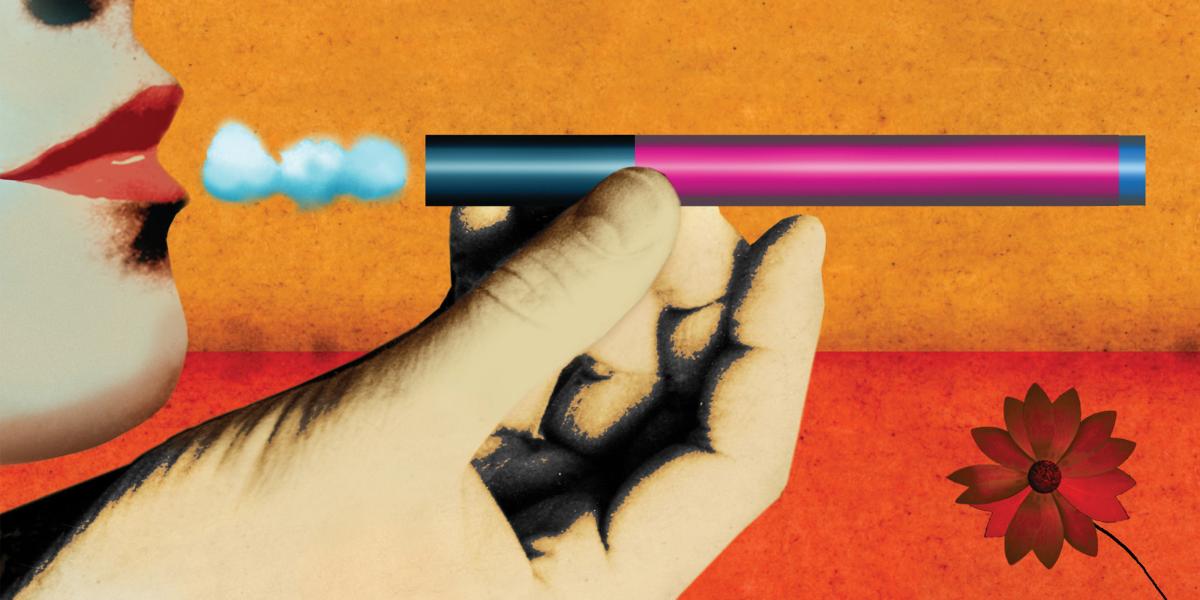All Steamed Up
Electronic cigarettes are everywhere: on commercials, in magazine ads and in the hands of their users—who are not called smokers, but “vapers.” That’s because while cigarettes burn tobacco, creating smoke, e-cigarettes heat liquid nicotine, creating vapor.
Some say the gadgets are a gateway to the greater danger of smoking, while others hope they might help eradicate that cancer-causing habit. Bloomberg School researchers interested in this issue—and a host of others posed by e-cigarettes—led a symposium on the topic May 2.
Patented in the U.S. in 1962, the nicotine-vaporizing device was commercialized by a Chinese pharmacist and for a decade has been marketed aggressively. Today, e-cigarettes come in some 250 varieties that resemble everything from cigarettes and cigars to pipes, hookahs, flutes and flasks. Their prices vary, as do the flavors—from mint to mango.
They differ from standard cigarettes, which burn tobacco, paper and additives to create smoke that delivers nicotine to the lungs—and ultimately the brain—in seconds. Traditional “combustibles” throw off about 7,000 toxins, more than 60 of which are known carcinogens. E-cigarettes, on the other hand, heat liquid nicotine, water and other chemicals, creating vapor.
“E-cigarettes expose the user and those around them to nicotine and a few other chemicals,” says K. Michael Cummings, PhD, MPH, a professor in Psychiatry and Behavioral Sciences at the Medical University of South Carolina. “But the aerosol generated is clearly less toxic than cigarette smoke.”
E-cigs are “much, much safer than cigarettes,” says symposium keynote speaker David B. Abrams, PhD, a professor in Health, Behavior and Society at the Bloomberg School and executive director of the Schroeder Institute for Tobacco Research and Policy Studies. “They are much less likely to cause the big diseases: heart disease, cancer, and chronic pulmonary disease.”
Joanna Cohen, director of the Bloomberg School’s Institute for Tobacco Control and an organizer of the event, agrees. “The expert opinion at this point is that they are much less harmful to the individual,” she says. “The question you have to ask from a public health perspective is, What are the implications at the population level?”
A primary public health concern is that e-cigs will renormalize smoking. “Young people say it’s not cool to smoke cigarettes right now. With this new device, we worry they will say it is cool,” says Maciej L. Goniewicz, PhD, PharmD, assistant professor of Oncology in the Department of Health Behavior at the Roswell Park Cancer Institute.
Cool, and wildly accessible. E-cigarettes, largely unregulated, are used where cigarettes now are forbidden; they are advertised in media where cigarettes have long been taboo. Some call it “the Wild West”—lawless and possibly full of potential.
“This is a disruptive technology,” says Abrams. “For the first time in a century we have a product that could make cigarettes obsolete. It’s the beginning of a revolution.”
Those who stand to benefit are smokers who make the switch from cigarettes, Cohen says, citing small studies that suggest that they might help some to quit smoking. While FDA-approved smoking-cessation products like gum, patches and lozenges are slow to deliver nicotine to the blood stream, some e-cigs have the potential to mimic the quick-hit of standard cigarettes. That, plus the fact that e-cigs can look and feel like the “real thing,” might make them helpful to the can’t-quit contingent.
“A nicotine patch is not a very good reward for a smoker craving nicotine,” explains Cummings. “It’s like telling my dog to wait two hours to get her treat. She learns much better if I give her the reward right away.”
However, if smokers keep on smoking and take up e-cigarettes, there’s no health gain. In fact, this kind of “dual use”—smoking when permitted and vaping when not—might extend rather than curtail a smoking habit.
“If you smoke an e-cig rather than a Marlboro, that’s a good thing,” says Cummings. “The problem is people who add an e-cigarette to their Marlboro smoking might not get any benefit.”
Researchers concur that regulating the sale and content of e-cigs is a good idea, as they can be packed with contaminants. While foes want to see them taxed and restricted like standard cigarettes, proponents of the product say careful regulation can help shape a healthier future. “I call it the Goldilocks formula,” says Abrams. “Not too hot and not too cold.” If e-cigs can be positioned at a lower price point with a higher nicotine punch, consumers may abandon cigarettes altogether, he says.
That sounds just right to some, but others are proceeding with caution.
“There aren’t a lot of data yet,” Cohen says. “People can give a lot of opinions; they aren’t right or wrong. We don’t know yet.”
